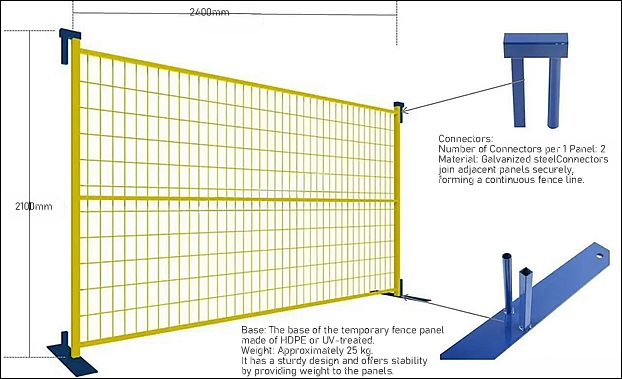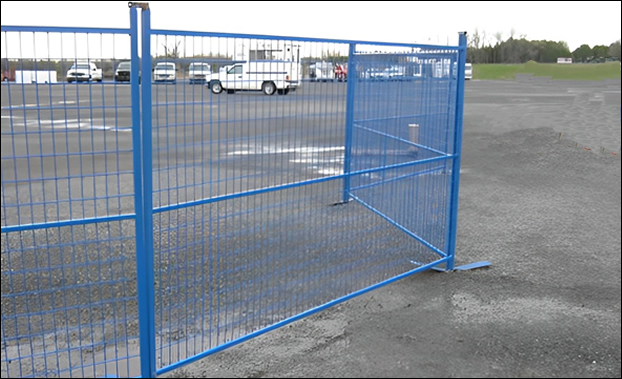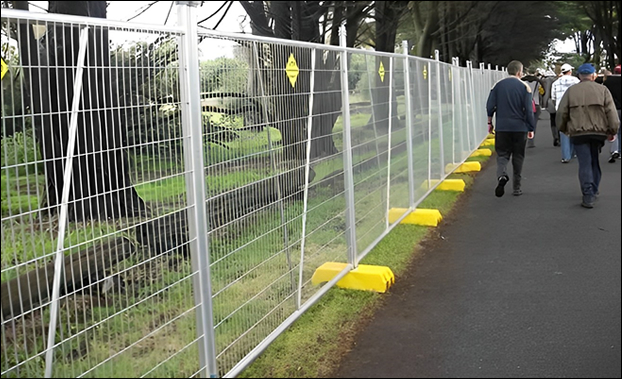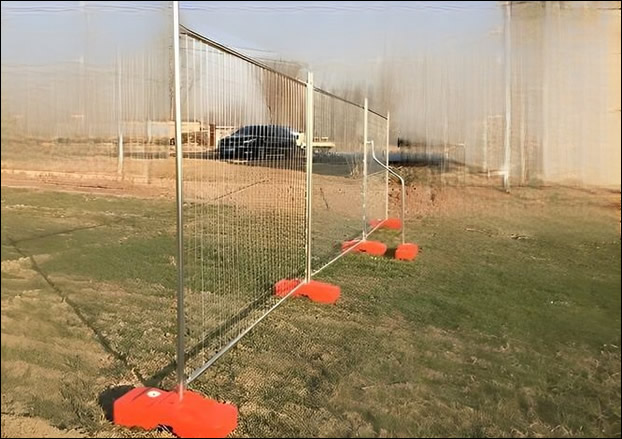Temporary Fence Manufacturer for Australia, New Zealand, Canada, and the USA
We provide temporary fencing solutions, designed to meet the specific needs of customers in Australia, New Zealand, Canada, and the USA. Our focus is on offering strong and reliable temporary fencing options, customized for the unique demands of each of these markets.
Comprehensive Temporary Fencing Systems by Frishine
Frishine specializes in offering mobile temporary fencing systems to meet various needs. Our product line includes:
- Welded mesh temporary fencing
- Woven mesh temporary fencing
- Chain link temporary fencing
- Frame-supported temporary fencing
These systems are made in modular fence panels for swift and easy installation, eliminating the need for ground excavation or foundation work, ensuring minimal disruption to the site.
Applications
Frishine’s temporary fencing materials are designed for a multitude of applications, ensuring safety and security of various projects:
- Construction and Private Property: Secure fencing to safeguard construction sites and private properties.
- Residential Projects: Fencing solutions for residential housing buildings.
- Event Management: Crowd control barriers and fencing for public events, including sports, concerts, festivals, and other gatherings.
- Swimming Pool Safety: Temporary barriers to ensure the safety around swimming pools.
Popular Styles
- Round Framed Temporary Fence Panels: Offering durability and ease of use.
- Galvanized Steel Temporary Modular Fences: Designed for long-term use with high resistance to corrosion.
- Woven Wire Fence Barriers: Ideal for a variety of secure enclosures with flexible installation options.
Finishing Options
Frishine offers temporary fence fabrics in three finishes:
- Galvanized
- Vinyl coated
- PVC coated
Modular Design for Easy Assembly
Our temporary fencing panels with frames are modular fencing systems for quick assembly:
- Welded mesh panels with round steel pipe frames
- Chain link fabric panels framed with round tubes or pipes
- Welded mesh panels with square or rectangular pipe frames
Tailored Solutions and High-Quality Standards
- Adaptable Specifications:
Our temporary fencing solutions are designed to meet common market standards across Australia, New Zealand, Canada, and the USA, also other markets. Variations and custom options are available for customers choice and produced with local regulations. - Customization and Compliance:
We offer customizable fencing solutions to meet specific requirements or local regulations. Our commitment to customization allows us to cater to various clients, ensuring that our temporary fencing solutions not only meet but exceed expectations. - Quality and Durability:
Our manufacturing process features the use of high-quality materials and superior quality adhering to the highest standards of safety and durability. We are dedicated to providing products that offer long-term reliability and performance. - Innovation and Improvement:
We are committed to ongoing innovation and improvement, aiming to anticipate and address the changing needs of our customers. By staying at the forefront of industry developments, we ensure that our temporary fencing materials remain the preferred choice for customers in Australia, New Zealand, Canada, and the USA.
Seeking for Excellence
Our temporary fence panels are manufactured conforming to precise standards and structural specifications, ensuring they meet the diverse and specific demands of the markets we serve.
Key Specifications of Temporary Fence Panels
- Panel Dimensions:
Standard Size: 2400mm in length by 2100mm in height.
Customization: Available to meet client-specific needs. - Wire Gauge:
Standard Wire Size: 10 or 11 gauge (3.5 – 3.2 mm in diameter), balancing durability with manageable weight. - Frame Tube Dimensions:
Standard: 32mm diameter for robust stability and strength.
Custom Options: 38.1mm outer diameter with a 2mm wall thickness for tailored requirements. - Base:
Material: High-density polyethylene (HDPE), ensuring a firm foundation.
Dimensions and Weight: 610mm (L) x 203mm (W) x 152mm (H), with an approximate weight of 25 kg. - Clamps:
Quantity: 2 per panel.
Material: Galvanized steel, offering rust and corrosion resistance. - Braces:
Material: Galvanized steel, providing extra support for extended configurations. - Panel Weight:
Average: 18-25 kilograms, including the base, ensuring both stability and portability. - Connectors:
Quantity: 2 per panel.
Material: Galvanized steel, for securely joining panels. - Supporters:
Material: Galvanized steel, essential for reinforcing long stretches of fencing. - Gate:
Dimensions: 1.8 meters in height by 3 meters in width.
Material: Galvanized steel, equipped with connectors and latches for secure access. - Tailored to Market Needs
These specifications demonstrate our commitment to providing high-quality, durable, and reliable temporary fencing solutions. By offering customization options, we ensure our products can meet the diverse needs of our clients and comply with local regulations, showcasing our flexibility and dedication to customer satisfaction.

Temporary panel dimensions: Standard temporary fence panels measure 2400mm in length and 2100mm in height, with custom sizes available to meet client needs.
Standard Temporary Fence Panel for Canada

The wire for temporary fence panels is usually 10 or 11 gauge (3.5 – 3.2 mm in diameter), offering durability without significant weight increase.

The frame tubes for temporary fence panels are 32mm in diameter, ensuring stability and strength. 32mm outer diameter pipes and a mesh infill of 4mm wires spaced 150mm x 60mm apart. Custom sizes are available with an outer diameter of 1.5 inches (38.1mm) and a wall thickness of 0.08 inches (2mm).

Reinforced temporary fence panels with orange feet base to ensure stable fencing.
Global Standards for Temporary Fencing
Temporary fencing is used to ensure safety and security for construction sites, public events, and other temporary applications. The standards for these temporary barriers vary significantly around the world, with each country adopting its own regulations and guidelines tailored to local needs and safety concerns. The standards for temporary fencing and guardrails are an essential aspect of public safety and regulatory compliance worldwide.
- Australia AS 4687-2007:
The Australian standard, AS 4687-2007, including the design, construction, and installation of temporary fencing and hoardings. This comprehensive standard describe the necessary materials, stability, strength, and durability of temporary fencing systems, ensuring they are adequately equipped to meet the demands of construction sites and public gatherings. It also provides detailed specifications for gates, connections, and the inclusion of warning signs to enhance safety and compliance. - New Zealand:
New Zealand’s approach to temporary fencing and guardrail standards is encapsulated within the Building Code, specifically through Clause F4, titled “Safety from Falling.” This clause mandates the implementation of barriers and guardrails to protect individuals from falling from elevated positions or into hazardous areas. The regulations detail the required materials, heights, and construction practices to be employed in the development of temporary fencing and guardrails, ensuring public safety and compliance. - Canada:
In Canada, the standards for temporary fences and guardrails are dictated by the specific regulations and guidelines of each province or territory. While these standards may differ across the country, they commonly cover essential safety considerations, materials, and installation practices. These regional guidelines ensure that temporary barriers meet the local safety requirements and provide adequate protection for workers and the public. - United States OSHA and ANSI Guidelines:
The United States maintains temporary fence and guardrail standards through the directives of the Occupational Safety and Health Administration (OSHA) and the American National Standards Institute (ANSI). OSHA’s regulations focus on safeguarding construction site safety, including the implementation of temporary fencing and guardrails to prevent falls and secure worker safety. Additionally, ANSI may issue standards that further define the specifications and requirements for temporary fencing and guardrail systems, ensuring a comprehensive framework for safety and compliance.
